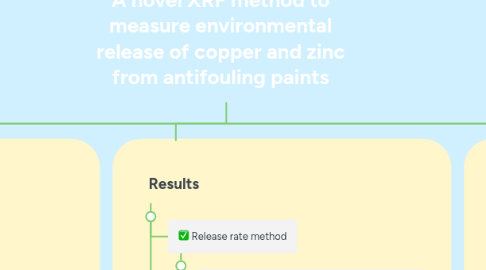
1. Introduction
1.1. The biocidal release rate from the antifouling paints can pollute ambient water.
1.2. Thus, a novel method using a handheld X-Ray Fluorescence spectrometer (XRF) is developed.
1.3. No reliable practical and low-cost method exists to measure the direct release of metals from antifouling paints.
1.4. XRF is used to determine the cumulative release of Cu and Zn from antifouling paints.
2. Materials and methods
2.1. Release Measurements
2.1.1. Five different antifouling paints are used
2.1.1.1. The coated panels (four replicates per paint) were attached and immersed along a pier in five different marinas in the Baltic Sea and Kattegat
2.1.1.1.1. After the exposure period, the panels were transported back to the laboratory and checked under a stereo microscope
2.2. XRF Method
2.2.1. Two different commercial biocide-free antifouling paints were used to develop antifouling paint standards
2.2.1.1. The area concentration, Carea (milligram/micro meter2), of the standards were calculated with the following equation: Carea = (Cpaint x m) / A
2.2.1.1.1. The calibration curves and a regression analysis were established
2.2.2. Statistical Analyses
2.2.2.1. Performed in JMP 11.0.0 to investigate the pairwise correlations for all three parameters
2.2.2.1.1. Multiple regression analysis was also performed
3. Results
3.1. Release rate method
3.1.1. A strong linear relationship between XRF Ka net intensities and metal concentrations, as determined by ICP-MS.
3.2. Cumulative release of copper and zinc form antifouling paints
3.2.1. Salinity has a strong impact on the release of Cu. The release increased with salinity.
3.2.1.1. The effect of salinity on Zn was not as evident.
4. Discussion
4.1. Released rate method
4.1.1. The observed difference between coatings is presumably a result of differing sample composition.
4.1.1.1. Mille Xtra, the paint with the highest combined metal concentration (Cu and Zn), showed the lowest dthin, persumably due to a higher degree of absorpton of X-rays by the heavy elements in the paint.
4.1.1.1.1. It is recommended to use coatings with dry film thicknesses less than 40 micro meter.
4.1.2. Cumulative release of copper and zinc from antifouling paints
4.1.2.1. The current data suggest the release of both Cu and Zn to be paint specific
4.1.2.1.1. Neither Zn nor salinity alone can explain the release of Cu for all investigated paints

